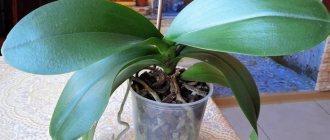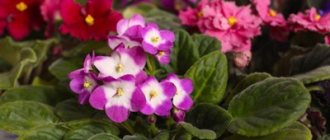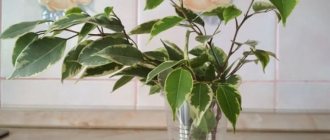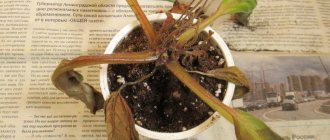What kind of pot is needed for planting ficus
Probably no one will argue that ficus is one of the most popular plants that gardeners grow at home. This flower is represented by both low-growing representatives (bonsai) and whole bushes reaching a height of 2-3 meters. A large number of varieties of ficus will allow everyone to choose what they like best.
An important point to pay attention to when growing a plant is choosing the size of the ficus pot. Many do not pay due attention to such a moment, but in vain, since so much depends on it.
How to choose the right container shape
The ficus pot should be selected depending on the size of the flower itself. If the plant has just been purchased and it is still quite small, then it is recommended to take a closer look at a small flowerpot.
You need to be much more careful when choosing a pot for a ficus that has been growing at home for a long time.
Experienced gardeners advise paying attention to containers of standard sizes, in which the diameter is equal to the height of the flowerpot. If you have a Rubber-bearing ficus or Benjamin ficus at home, then such a pot will be an ideal option.
When planting a tree from which you want to create a bonsai, you need to understand that choosing a flowerpot will be a little more difficult. Many novice gardeners buy what they like best based on appearance, and this is completely wrong.
Important! A bonsai pot should be flatter, resembling a plate in appearance rather than a flowerpot.
A container or thicket is something that is in great demand. In addition to the fact that such containers are very convenient, they will fit perfectly into any interior of an apartment or office.
When thinking about which pot to plant a flower in, you need to understand that any shape can be changed artificially. Of course, no one will deliberately remake the container, but there is an opportunity to cheat by weaving a flowerpot in which a vase can be placed. Tall products look beautiful and original, ideal for bonsai and other forms.
Pot size - how to choose it
Some believe that the pot for Ficus Benjamin can be anything. Even one left over from some other flower, for example, will do. If you act according to this principle, you may encounter the fact that the plant stops growing, begins to wither, and then dies altogether.
Experienced flower growers say that “We choose the size depending on the development of the flower roots.” There is no point in planting young plants that have small roots in large flowerpots, since the ficus will stop growing due to the fact that the root system begins to actively develop. And until it entwines the entire earthen lump, the situation will not change.
However, this does not mean that you should wait until the roots appear from the drainage holes.
If the flower has not been replanted for more than a year, you need to take out the earthen ball along with the flower and carefully examine it. Having noticed a developed root system, it is necessary to transplant the ficus into a pot that will be several centimeters larger than the previous one.
Important! Rubber-bearing ficuses grow very quickly, so you will have to buy a new pot for them every year.
The mistake many gardeners make is that when planning to plant a tree, they transplant an already quite large flower into a container that is slightly larger than the previous one. This rule must be followed for those flowers that grow on the windowsill. For floor ficuses, you should buy fairly spacious flowerpots. Considering that adult and large plants are not replanted, their top layer of substrate is simply changed annually, it will be very difficult to transplant a flower into a larger pot. The plant may simply not take root in the new place and die.
Correct formation of the crown of ficus rubber
Sometimes the ficus grows as a rather unsightly bush with one main stem. In order for the plant in the flowerpot to turn out lush, it is necessary to plant several shoots at once and regularly rotate the pot. If it is not possible to plant several plants, you can try two more ways to stimulate the growth of side shoots.
- Piercing the main stem to a depth equal to one-third of the total diameter of the stem. The first puncture is made in the upper part of the trunk, then several more punctures can be made below.
- The crown of the ficus is tilted down and fixed in this way. The bud that is higher than the rest will certainly begin to grow. When side shoots appear, the plant can be returned to its usual position.
Material – what is better to pay attention to
Despite the fact that ficus plants are quite unpretentious plants and can “live” in almost any pot, it is still recommended to pay attention to the material from which it is made.
You need to understand that not all containers are safe; we are talking about toxic materials, from which flowerpots can also be made. Some manufacturers, in order to save a little on production, use poor quality plastic, which begins to release toxins when it comes into contact with soil, water or fertilizers. It is the latter that adversely affects the plant.
There have been cases when a flower began to gradually fade, but the reason could not be found. And only an accidental transplant into a new container saved the situation.
Therefore, when thinking about what kind of pot is needed for a ficus, it is best to choose proven materials.
These include:
The latter material is relevant for the manufacture of large tubs that can decorate any room.
As for clay containers, they are usually used for planting bonsai.
Ceramics is an expensive material, but it is beautiful, durable and, of course, natural, so if possible, it is worth paying attention to it.
If the florist is well acquainted with the manufacturer and has repeatedly purchased pots from the represented company made of plastic, then you can purchase them. At the same time, having noticed some negative changes occurring with the flower, and also having ruled out all possible problems, it would not be a bad idea to change the flowerpot by purchasing a pot made of natural material.
Shaping without trimming
Before pruning the rubber ficus, you should think about whether it is possible to make the crown beautiful without a traumatic procedure. These methods include:
- kerbovka;
- graft;
- use of cytokinins;
- manipulations with lighting - this way you can correct a “one-sided” or curved crown;
- giving the shoots a vertical position.
The method of making the rubber-bearing ficus branch by bending the trunk should be discussed separately. Yes, the side buds will come to life if the shoot takes a horizontal position. So, what is next? By the time new branches appear, the trunk will have time to harden. And how can such a miracle be made to straighten up? The main shoot will never be perfectly straight. Only radical pruning will correct the situation.
Recommended topic:
Soil for ficus: Benjamin, Rubber, Lyre-shaped and other types
How to water ficus correctly and often at home
Fertilizer for ficus: what to feed at home
Ficus does not grow, stands still: reasons, what to do
Ficus Rubber (Elastica): care and transplantation at home
Ficus Elastica Tineke: description of the variety and features of care at home
I like34I don't like
Which color do you prefer?
Perhaps this is the simplest thing that can be. Today there are so many color options on the market that choosing the right pot for your ficus is not difficult. Some gardeners advise paying attention to light colors, which harmonize very beautifully with the green shades of the leaf plates. If you purchase a ceramic flowerpot, then you can take a closer look at products that have a whimsical and delicate design.
By choosing the right pot, the flower will grow quickly and develop well.
Which pot to choose for Ficus Benjamin and other varieties?
Standard flowerpots are more suitable for young plants. And adults are better grown in large tubs with a volume of 10-15 liters or more.
When choosing a container, you need to pay attention to the following criteria:
- container sizes;
- shape;
- coloring;
- material;
- the number of plants that will be planted there.
In fact, a flowerpot for a tree is not only its habitat. It is also a tool for shaping its trunk and crown. Therefore, you should approach the choice of container for growing a flower responsibly.
How to choose the right form?
The most ordinary flowerpot will suit the plant. The presence of special refinements in its design is not necessary. The ideal option is to plant it in a pot of the correct shape. Its width and height will be approximately the same. This form is suitable for any variety of ficus.
But if you want something special, you need to consider the following nuances:
- It is better to avoid a round shape. In the process of transplanting a flower into such a pot, there is a risk of injuring its root system. Then the flower will be very sick.
- In a pot that is too elongated, the volume of soil will be much higher than normal. This can lead to a slowdown in tree growth. It will begin to devote its energies to growing roots, and only then will it continue to grow in height.
- A flat container is more suitable for growing bonsai. It will be shaped more like a bowl than a flowerpot.
Substrate and feeding
Ficus Benjamin kinki is not a whimsical plant, but a little capricious, so when replanting you should use a special substrate intended for this species. If the plant is young, then it is necessary to add loose soil when replanting at home, which will allow the plant to take root better. After the plant gets stronger, its root system becomes strong, it can be transplanted into a denser substrate. If you do not have certain knowledge and skills, it is best to consult a specialist.
As for feeding, the determining factor here is the substrate in which the flower will develop; as a rule, organic matter is used in spring or summer, once every two weeks is enough. At the same time, in order to properly cultivate the soil, it is necessary to use organic and mineral fertilizers in turn. You can use special fertilizers or raw materials intended for deciduous plants.
In winter, the flower rests, it is not fertilized, but if the most ideal conditions are created in terms of humidity and air temperature, as well as lighting, then fertilizing is possible. Florist specialists recommend fertilizing the soil for Benjamin kinky at home with a weak dose of organic matter, half the usual dose, for one or two months.
When choosing fertilizers for ficus, you should pay attention to the nitrogen content; you need a lot of it, especially when the flower grows and develops during the growing season. When there is such a large amount of nitrogen in cold weather, as in summer, the plant must rest during the dormant period, its active growth is undesirable
The organic mixture is diluted with water and the resulting solution is used for watering; if it is planned to use concentrated fertilizer, then it is applied at the very root, but after watering, to prevent burns to the plant and its root system.
If you properly care for Kinki throughout the year, it will grow well and delight you with its blooms. In addition, it should be noted that a ficus such as Benjamin Kinky cleans the air at home from dust much better than other indoor plants. This fact has been scientifically proven.
The video will tell you more about which pot to use for transplanting ficus benjamina kinki at home, the substrate, and how to carry out the procedure correctly.
Post Views: 1,496
- Which indoor flowers to choose for your home
- What indoor plants purify the air?
- What flowers symbolize love
- The most unpretentious indoor flowering plants
Is it possible to plant several flowers in one container?
Ficus trees are often used in the interior design process. If you plant 2-3 shoots in one flowerpot, you can form a beautiful composition from them. But to do this, you need to understand how to properly weave together several trunks.
When planting several trees in one pot, the following recommendations must be followed:
- Choose indoor crops of the same height - within 15-17 cm.
- If the trunk is woody by more than half, such a plant is no longer suitable for creating a composition. It may break during the weaving process.
- If there are only two plants, they can be braided in a spiral shape.
- In the case of using dwarf varieties, it is enough to twist the trunk once. For other trees, you can continue to twist their stems as they grow.
- Volumetric or tall flowers require additional support during the weaving period. Then the tree will be protected from distortions and falls. After the process is completed, the frame can be removed.
- It is advisable to secure the contact points of the shoots with wire or strong threads. Then they are guaranteed to grow together into the required shape.
The most common type of weaving is the braid. It is also one of the simplest and even a beginner can do it. More experienced gardeners can try weaving plants into a trellis or hedge.
Correct formation of the crown of ficus rubber
Sometimes the ficus grows as a rather unsightly bush with one main stem. In order for the plant in the flowerpot to turn out lush, it is necessary to plant several shoots at once and regularly rotate the pot. If it is not possible to plant several plants, you can try two more ways to stimulate the growth of side shoots.
- Piercing the main stem to a depth equal to one-third of the total diameter of the stem. The first puncture is made in the upper part of the trunk, then several more punctures can be made below.
- The crown of the ficus is tilted down and fixed in this way. The bud that is higher than the rest will certainly begin to grow. When side shoots appear, the plant can be returned to its usual position.
A ficus pot is a cozy “house” and a guarantee of plant health
Indoor plants are elements of living nature that can be easily “built” into the interior of any room and style. Flowers, mini-trees, bushes fill the house with warmth, draw attention to themselves, and create a special, comfortable atmosphere. Ficus trees are one of the most popular house plants. Almost all of them are unpretentious in care and at the same time exquisitely decorative. A significant role in preserving their health and beauty is played by the correct choice of the container in which they grow. Knowing how to choose the right pot for a ficus will help provide your green pet with the best conditions for it.
Protecting ficus from pests and diseases
The main pest of decorative ficus is scale insects. A sticky substance on ficus leaves and the smell of rot are the main signs of its presence.
In addition, the plant can be affected by thrips, spider mites, and mealybugs. The main harm from most parasitic insects is that they suck out the sap of the plant and leave a brown or brown coating on the leaves. Thrips carry dangerous diseases.
To combat scale insects and other parasites, a simple folk method is effective, the essence of which is to simply periodically wipe the leaves and stem of the tree with a solution of laundry soap. In addition, you can give the plant a “soapy” shower. In this case, it is advisable to protect the soil from the solution (for example, using a film).
For spider mites and scale insects, use a solution with the addition of industrial soap and washing powder. And to treat noticeable infestations, insecticides (such as Aktelik) are needed.
If you choose the best ficus for yourself and take care of it, it will bring beauty, peace and joy to your home. We wish you that your favorite flowers show only their best sides!
What kind of pot is needed for ficus
It is believed that unglazed clay pots for indoor flowers are the best option because the clay is porous and allows air to circulate. This has a positive effect on both the regulation of soil moisture and the supply of oxygen to the roots. However, ficus plants are not picky about the material from which the container is made - it can be ceramic, clay or plastic. The only thing that all types of crops fundamentally need are drainage holes and a “spout” on the tray to drain excess liquid. You can plant a young ficus or transplant an adult plant even into a cheap plastic pot - and if you follow simple care rules, the owner of the flower will receive a healthy and well-developed flower, bush or tree.
Pot shape
For most “natural” ficus plants (that is, excluding trees formed in the bonsai style), standard-shaped pot models with approximately equal height and diameter, as well as holes at the bottom (to ensure drainage of the plantings), are suitable.
Diseases and pests
These are quite powerful and strong plants. Ficus elastica diseases are quite rare. With proper care and proper watering, the plant actively develops and grows.
Dry and wrinkled leaves may appear in hanging and bush varieties due to dry soil and low humidity levels. It is necessary to normalize watering and spray more often. The same symptoms can appear with sunburn. In this case, it is enough to move the plant to a more suitable place where it will not be exposed to direct sunlight.
If you notice that the leaves of a plant have begun to turn yellow, then experts believe that there may be several reasons for this: drying out or waterlogging of the soil, drafts, insufficient lighting.
Some leaf diseases can be caused by pests. Most often they appear in rooms with high levels of humidity (fungal infections) or too low (aphids, nematodes, spider mites, scale insects). To prevent pests from injuring the plant, preventive inspections should be carried out.
If you notice small spiders on the bottom of the leaves, then you should know that these are spider mites, which multiply rapidly in high temperatures and dry conditions. To destroy it, the plant is washed with a weak solution of tobacco dust with the addition of soap.
To get rid of shield aphids, you can use the same soap and tobacco infusion, adding a few drops of alcohol or kerosene to it.
Features of choosing a container for bonsai
The following rules will help you correctly determine the size of the pot for ficus bonsai, taking into account the aesthetics of the plant’s appearance:
- the depth of the container should be equal to the diameter of the trunk just above the ground level;
- for trees with a particularly wide crown, select a wider pot;
- For trees with a very thick trunk (compared to their height), deeper vessels are chosen.
In addition, bonsai experts believe that the shape of the vessel should be in harmony with the tree. According to their appearance, bonsai plants are conventionally divided into male and female (this depends only on the opinion of the owner):
- male trees have a strong trunk, strong, mature bark, and often have sharp angular branching. They look good in containers with pronounced corners - square, rectangular;
- Ficus bonsai are considered to be female if they are more refined, with smooth bark, as well as smoothed lines of bending branches. Oval or round containers are suitable for them.
A properly selected flat bonsai enhances the aesthetic pleasure of contemplating the tree as a work of art. If we take into account only gardening considerations, almost any flat bonsai pots with a wall height of no more than 10 cm will do.
The “charm” of ficuses, in addition to their many other advantages, also lies in the fact that they are not picky in terms of the shape and material of the pots. Therefore, taking into account the size of the root system and the method of growing the plant, you can select a variety of vessels for them, harmoniously fitting them into the interior style of the room.
Description of appearance
Ficus is a fairly large plant. In its natural habitat, it can reach a height of 30 meters and form a lush crown. A tree can grow no less grandiosely in breadth. This occurs due to the presence of aerial roots. These roots form on the trunk and branches, and then go down to the ground and grow into the soil. Thanks to aerial roots, the ficus receives additional nutrition. Due to the formation of a large number of these twisting roots in its homeland, the plant received the name “snake tree”.
The plant has large leathery leaves of an ellipsoidal shape and a dark green color. The leaves are arranged alternately and slightly pointed at the top. Young leaves are light in color and the stipules are reddish-brown. As soon as the young leaf unfolds, the stipule dries out and falls off.
The flower of the plant has no aesthetic significance. It appears only in cases where pollination by insects occurs. In an apartment or private house, this is unlikely. An adult tree can bloom and form fruit only if it was grown in a fairly spacious winter garden. The fruits are small in size and resemble unripe figs in appearance.
At home, rubber ficus grows to a height of no more than 2 meters. Despite this, its growth rate is quite high. With proper care, the plant can add 40–50 cm in a year. And even if the house ficus begins to rest its top on the ceiling, it can always be trimmed. The plant, as a rule, does not produce side shoots at home.
Caring for ficus microcarpa at home (10 photos) How to care for a ficus flower at home Growing abutilone from seeds at home Keeping dracaena at home and rules for caring for it Caring for alocasia at home
Planting ficus in Italian flowerpots
- 0.0 Rating 3441 Views 1 comment
In this article we will tell you about ficus: about replanting, care, selection of flowerpots or flowerpots, and the possibilities of using ficus in landscaping.
Ficus (ficus) is an ancient charming plant that grows in the tropics and subtropics. Ficus belongs to the mulberry family (Moraceae). It thrives indoors all year round. In the warm season, you can place the plant on the terrace or balcony. Ficus has many types. Let's list some of them:
“Benjamina” “Binnedijka” “Rubber” (“Elastica”) “Carika” (fig) “Lyre-shaped” “Bengal” “Sacred” “Tiny” “Rooting”.
The forms of the plant are also varied: shrub, dwarf shrub, hanging tree, standard tree, bonsai.
The color of the leaves can be monochromatic, or it can combine two or three colors. For example, the “Ali” variety is monochromatic, “Kinki” is green and the color of baked milk, “Belize” is gray, pink and green. The shape and size of the ficus leaf are also very diverse: oval, heart-shaped, lyre-shaped, carved, with a wavy edge; from 2 to 30 cm in length, from 1.5 cm to 7 cm in width.
Caring for a ficus will not be a hassle if you love your plant and care for it properly. The plant loves diffused light, but can also tolerate partial shade. The desired temperature range is from plus 12 to plus 30 °C. Watering depends on a number of factors: time of year, location of the plant, proximity to heating radiators (air conditioning systems), size of the pots, soil. Based on the fact that a large number of factors are more difficult to take into account, we recommend taking a simpler but proven path - watering as the earthen clod dries out to a depth of 4 cm (two phalanges of the index finger). If, when penetrating to this depth, the earth crumbles, it’s time to water; if not, it’s too early. We recommend watering with settled, slightly warm water. There is no need to heat the settled water; take hot boiled water and mix it with the settled water in a bucket. Ficus loves to be sprayed with slightly warm water. Some species, for example ficus "Ali", are resistant to cool air flows (air conditioning). Ficus plants react negatively to stagnant moisture in the pots, at the roots, so you need to be careful when choosing a pot and flowerpot! You should not use ceramics coated with glaze: it has low air permeability. With proper care, ficus trees rarely get sick.
Ficus transplantation is an interesting and useful thing! Interesting - because the result will not be long in coming - you get a harmonious picture of the relationship between the plant and the new flowerpot. It is pleasant for your eyes, as well as for your guests, to contemplate a fresh composition. Useful - because replanting gives the plant new vitality and growth impulses. For replanting, you can take specialized soil for ficus and palm trees. It is possible to add high-quality universal soil to this soil, up to half the total volume of soil in the pot. In addition to the soil, it is necessary to prepare drainage, which will most likely be expanded clay.
Now you can start selecting flowerpots for your ficus. The GARDICA.ru online store offers you a large selection of flowerpots. Pots differ in material, shape, color, volume, presence or absence of a tray, and self-watering system. What unites the pots and flowerpots we offer is that they are made in Italy by true masters of their craft. The choice is yours! recommends using pots and flowerpots made of bulk plastic for replanting, because, firstly, the ficus and flowerpot can spend part of the year outside, and secondly, large and medium-sized specimens need a reliable and durable pot. Read more in the article about volumetric plastic
.
First, let's look at the classic planting option - transplanting into a pot with drainage holes and a tray. Four cross-shaped holes will be enough. For pot LIRA
with a volume of 25 liters, the manufacturer has provided four holes with a diameter of 2 cm. We fill the bottom of the flowerpot with a layer of expanded clay 3-4 cm high, followed by the prepared soil. We remove the ficus from the pot in which it is located. If this is a transport technological pot, then you can simply cut it. If it is a soft plastic pot, you can press it a little from the bottom and sides, pushing the earthen ball with roots out. If it is a pot with dense walls, then it and the plant should be placed on its side and knocked on the walls of the pot, as if shaking the plant with an earthen lump out of the pot. If it's a ceramic pot, be careful, it may break! If you transplant from a bulk plastic pot, this moment will not bother you: the pot will not break. After you have removed the plant with a lump of earth from the previous pot, gently shake off the soil or peat and re-evaluate the size of the ficus root system. This will allow you to understand how much soil needs to be filled in after expanded clay. Fill the soil, install the ficus with a ball of earth on it, cover the roots of the plant with soil, compact the soil around the perimeter of the flowerpot. Near the trunk, tamp thoroughly, but carefully, without putting much pressure on the root system. The soil should not reach 2-4 cm to the edge of the pot, otherwise watering will be inconvenient, the water will pour over the edge without having time to wet the soil. After transplanting, water the ficus with slightly warm, settled water. High-quality European fertilizers can be added to the irrigation water after transplantation to promote rapid and healthy rooting. Wipe away any dust that gets on the leaves during replanting, and spray the ficus with high-quality wax for indoor plants. The top open layer of soil can be mulched with expanded clay, marble chips, pebbles, pine bark, decorative stones or colored chips.
Home care
If you are thinking about buying an indoor tree, then keep in mind that all types of ficus grow happily in apartments. They will not only give visual pleasure to their owners, but will also purify the room air. To successfully grow these plants, you need to know how to properly care for ficus at home. This does not require much effort: only a few features are important when observing the watering regime, trimming branches and leaves.
Watering
At any time of the year, ficus loves moderate watering; you cannot “overwater” the plant, otherwise it will get sick and die. The soil should be moistened when the top layer is completely dry. It is impossible to say with certainty how many days this will happen: the rate of dehydration depends on the temperature in the room. Watering should be done approximately once every 7 days with warm, settled water. The drained liquid should be poured out half an hour after the procedure.
Once every 15-30 days it is necessary to give indoor plants a light shower using warm water. To do this, the plants are transferred to the bathroom and watered from the shower head. Thanks to this procedure, dust is washed off from leaves and branches. If there are insects or pests on them, they will also be washed off. After the shower, the plants should stand in the bath to let the water drain, then send the flowers back to their place. From such procedures, the leaves become glossy and well-groomed.
Trimming
In order for your ficus to have dense foliage and a neat appearance, it is necessary to regularly trim the overgrown thin branches. Examine your plant carefully from all sides: you will see that there are several branches without leaves or half-naked. In order to revive and awaken the dormant buds on the plant, you need to pinch (cut off) the young light green shoots (leaves) that frame the ficus. This procedure should be carried out several times a year as needed. After pruning, after some time, the long-awaited leaves will begin to appear on the bare branches.
Ficus pot
Ficus belongs to those types of plants for which it is practically unimportant what material the pot is made of. The main thing is that this material does not have a chemical effect on the substrate it contains and the ficus pot looks aesthetically pleasing in accordance with the interior of the room.
Traditionally, vessels made of clay, plastic and wood are used, and the choice depends on the preferences, tastes and capabilities of the grower. But at the initial stage, for growing an individual that has just begun to develop, it is preferable to use clay containers that are not covered with glaze, since they allow moisture and air to pass through well. At the same time, you should not place ficuses in clay pots on sunny windowsills, since clay tends to heat up very much, which leads to a general increase in temperature in the pot, which contributes not only to the drying out of the substrate, but also to the withering of the plant.
Standard products are suitable for young individuals, but adults (more than 3-5 years old) will need large containers with a volume of several tens of liters, such as a wooden tub, a large plastic container or a voluminous flowerpot. You need to select a pot for ficus taking into account the shape, size and type of plant.
The shape of the pot for the vast majority of varieties and types of ficus ideally fits the standard shape, with a height close in value to the diameter. But there are also cases when preference is given to vessels of a different shape. An example of this are flat pots, bowls and plastic containers with a side height of at least 10 cm, used for growing trees using elements of the bonsai method that is popular today, for which many types and varieties of ficus are excellent.
Description of the flower where it grows in nature
The genus Ficus (Ficus) is the most interesting representative of the mulberry family (Moraceae). It occupies a special place in terms of its unique variety of shapes and colors, the number of its species and its prevalence in the world. More than a thousand species of this genus are found in tropical forests around the world.
- Description of the flower where it grows in nature
- Types and varieties of rubber ficus with photo Small-leaved
- Variegated
- Variety Shriveriana
- Miniature variety Melanie
- Robusta
- Tineke
- Lighting and temperature
- Why do the leaves turn yellow and fall off?
These plants are native to northeastern India and southern Indonesia. They grow in tropical forests. Ficus growing in its homeland is visually different from indoors.
The diameter of the ficus trunk reaches 2 meters. The plant grows and develops for 50 years, then dies.
At first, the ficus looks like a single-trunk tree. As it grows, branches appear. Aerial roots form from numerous branches, they hang down and, touching the ground, go deeper into it, thereby providing the ficus with additional nutrition.
The leathery leaves are ellipsoidal in shape, with a pointed tip. Their length reaches 30 centimeters. Width - 15 centimeters. The color of the outer side of the leaf is green. It may show different shades and patterns. The color of the underside of the leaf is matte, soft green. The central vein is pronounced, slightly pressed into the leaf blade. The leaves are arranged alternately.
Young plants growing indoors need support as they may break. When a stem or leaf is broken, a thick white liquid containing isoprene flows out. When a wound appears, it should be lubricated with petrolatum, sprinkled with crushed activated carbon or bandaged. If the milky juice gets on the skin, it can cause a burn; to avoid this, it should be washed off immediately with soap and water.
Only very large plants produce flowers and fruits. The inflorescence of ficus (syconium) looks like a pear-shaped or capitate axis, with a hole on top and a void inside. Small (about 1 millimeter long) flowers form on the inner surface of the walls. After pollination they turn into fruits. They grow together with the wall of the inflorescences and form infructescences. The fruits are similar to figs, but are not edible. They have a small, round shape and small seeds.
In the store, most ficus trees do not exceed half a meter in height and have about 5-7 leaves. You can also find older plants reaching 1 meter in height. Indoors the flower grows up to 10 meters.
In favorable conditions, the plant grows 60-100 centimeters per year. Variegated varieties grow by 25-30 centimeters.
Ficus pot sizes
It is selected based on the size and degree of development of the root system of the plant that is supposed to be planted. The ficus pot should not be too loose. It is recommended to choose a vessel, always with a bottom drainage hole, in which the roots of the plant do not reach the walls of the vessel by about 1.5-2 cm. You also need to take into account that at the bottom of the vessel it is necessary to arrange drainage from expanded clay or brick chips. When transplanting young or developing ficus specimens, the pot should be 2-3 cm larger in diameter than the previous container.
During the process of plant formation, the volume of the vessel can be reduced; in this case, careful pruning of the roots is necessary, accompanied by pruning and shaping of the crown.
You cannot plant a ficus in a pot that is too spacious for it. As a rule, this leads to undesirable consequences, such as souring of the soil in the vessel that is not inhabited by the root system and, as a consequence, rotting of the roots, often leading to the death of the plant. Also, there are types of ficus for which a spacious container is simply contraindicated.
Since ficus is a large plant, and in natural conditions some of its species grow up to 10-15 m in height, the size of the container can serve as a tool for adjusting growth limits. Keeping an individual in a container that is too tight for its root system will stop the growth of the above-ground part of the plant.
Reproduction
Ficus reproduces in four ways:
- Cuttings, which in turn are of two types - stem and leaf-bud. Cuttings are placed in water until roots appear, usually after two weeks. Then each shoot can be planted in the ground in a separate pot.
Air layering. This method of reproduction requires more attention. You need to select a shoot and remove excess leaves. Then make a cut around the trunk in a circle, into which insert a match or a piece of wood. Wrap the cut area with damp moss and polyethylene on top. Within a month, the roots should germinate, then the shoot can be separated from the main trunk and planted in a separate pot. At home, ficus plants practically do not reproduce by seeds; this is a very labor-intensive and time-consuming process. To create ideal conditions, a mini greenhouse is used, in which the seeds are sown. It must have high humidity and appropriate temperature.











